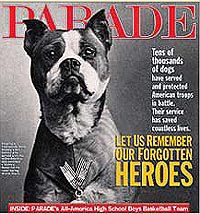Breeder/Working dog/Show dog enthusiast. Next to temperament (confidence and friendliness) movement is the next most important aspect of the breed. Give me a happy, outgoing, playful, not afraid of anything, dog that moves efficiently and is not overly massive and I'll show you a dog that can do anything.
American Pit Bull Terrier moves with a jaunty, confident attitude, conveying the impression that he expects any minute to see something new and exciting. When trotting, the gait is effortless, smooth, powerful, and well coordinated, showing good reach in front and drive behind. When moving, the backline remains level with only a slight flexing to indicate suppleness. Viewed from any position, legs turn neither in nor out, nor do feet cross or interfere with each other. As speed increases, feet tend to converge toward center line of balance.
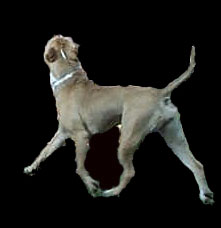
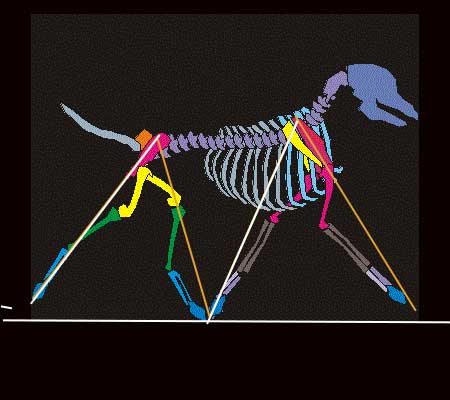
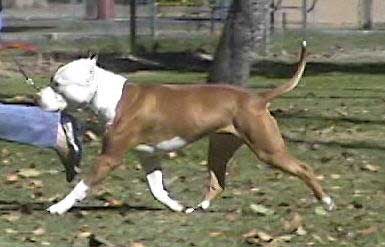
FIGURE 19- The top left photo shows a dog gaiting at a slow pace exhibiting proper reach and drive as well as a tail carried in challenge position indicating excitement or enjoyment. The skeletal representation provides an indication of what is occurring at the shoulders and hips. The WHITE LINES indicating drive and the ORANGE LINES indicating reach. Notice the top line on both of these figures remain level and the heads are carried at a 45 degree angle while moving indicating well laid back shoulders. Improper shoulder set or short overly muscled necks for instance would prevent the dog from carrying the head high with confidence and would instead give the look of trundling. Without proper angulations, hip and shoulder set, improperly overreaching or shortened reach and/or drive are exhibited. The final picture is a dog that is really moving fast and exhibiting AMAZING form. IF a dog can move nicely both at a slow and a faster gait you have a dog that is well put together.
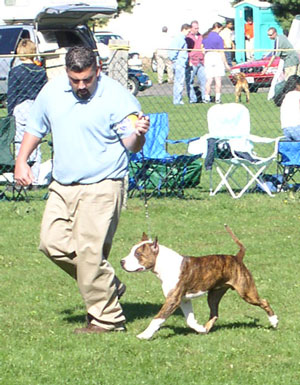
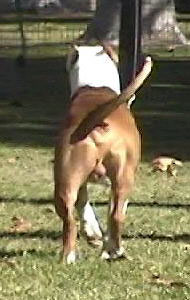
Judging movement is a fine art. One thing I have often heard is that we look for the dog that moves perfectly, smoothly and efficiently from the side and if their down and backs are good that is a big plus. If the dog does not appear to move efficiently from the side but has a good down and back it is OK but not preferred.
MOVEMENT PRIMER ON VIDEO
FLASH!!!! We now have a small library of "slow motion movement movies" (say that 3 times fast). Designed to help you understand the mechanics of movement using actual models. These movies are between 250-500kb in size. To get them any clearer would make them much bigger. We spent a lot of time and effort getting these in here I hope you appreciate what we are providing (If you want to contribute the best way is using a digital video super 8 with good zoom.) We have actual UKC judges that will provide honest critiques of the movement. You may not like what you hear but it will help everyone learn. You can send us your tapes and we will get them into the computer in a format available to everyone in browser. |
Faults: Legs not moving on the same plane; legs over reaching; legs crossing over in front or rear; rear legs moving too close or touching; rolling; pacing; paddling; sidewinding; hackney action; pounding
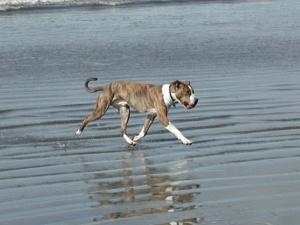
Overreaching. Notice the rear leg has landed forward of the front leg. This pretty guy crosses inward to avoid hitting his own front foot. This is a fault. (TOTAL THANKS FOR THIS GREAT PIC!!!!)
Convergence
An often misinturpreted meaning. The APBT should not move on a centerline line an American Eskimo would. The Eskie is a classic gaiting breed and their movement is a wonder to behold. The APBT is not a gaiting breed. They were designed for a different purpose and thus their movement must reflect this. They were build for strength, agility, and endurance. Thus movement tends toward a centerline as a function of balance but never reaches the centerline. This is primarily a functin of the layback in shoulders and the front and rear balanced angulation. Thus we find that there is convergence but it only tends to increase with speed. Remember tendency is not a strong word!
|
|
|
| Above is a dog with proper foot placement but there is no convergence toward the centerline. This is typical of digging breeds for instance such as dachshunds but APBTs will move a bit like this at slow trots though they should move more toward the centerline optimally. Typical of breeds with extreme layback of the shoulder assembly. | This is a dog with proper foot placement that tends toward the centerline when moving. This is proper for gaiting breeds such as the APBT. The APBT standard indicates that movement tends toward a centerline as speed increases. Typical of breeds with moderate shoulder layback. | This is a dog that gaits on the centerline. This is typical of herding breeds and galloping breeds such as sight hounds. This is typical of dogs with a very steep shoulder set. The APBT should not typically move ON a centerline. |
 |
 |
 |
| This shows a typical fault. The front move on a different plain than the rear feet. Here the front converges correctly (for the APBT) while the rear over converges (moving too close) and runs the centerline. This would be indicative of a faulty rear angulation in the APBT. (other causes possible) | This is another typical fault often seen with dogs with short backs and/or too much rear angulations. Here the rear feet placement overreaches the front. (other causes possible) | Here is another typical fault where the rear feet do not quite land where the front placement was. This is under reaching. Very typical in the APBT as a fault and associated with not enough angulation in rear or too step shoulder set preventing adequate front drive. (other causes possible) |
To visualize movement both good and bad after you read this page visit our movement library
Movement Study 1 | Movement Study 2 | Movement Study 3 | Movement Study 4 | | Movement Study 5 | Movement Study 6 | Movement Study 7




